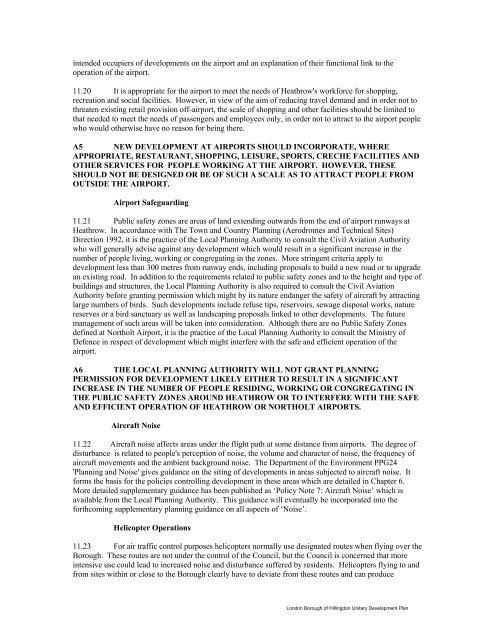HILLINGDON UNITARY DEVELOPMENT PLAN - London Borough ...
HILLINGDON UNITARY DEVELOPMENT PLAN - London Borough ...
HILLINGDON UNITARY DEVELOPMENT PLAN - London Borough ...
Create successful ePaper yourself
Turn your PDF publications into a flip-book with our unique Google optimized e-Paper software.
intended occupiers of developments on the airport and an explanation of their functional link to the<br />
operation of the airport.<br />
11.20 It is appropriate for the airport to meet the needs of Heathrow's workforce for shopping,<br />
recreation and social facilities. However, in view of the aim of reducing travel demand and in order not to<br />
threaten existing retail provision off-airport, the scale of shopping and other facilities should be limited to<br />
that needed to meet the needs of passengers and employees only, in order not to attract to the airport people<br />
who would otherwise have no reason for being there.<br />
A5 NEW <strong>DEVELOPMENT</strong> AT AIRPORTS SHOULD INCORPORATE, WHERE<br />
APPROPRIATE, RESTAURANT, SHOPPING, LEISURE, SPORTS, CRECHE FACILITIES AND<br />
OTHER SERVICES FOR PEOPLE WORKING AT THE AIRPORT. HOWEVER, THESE<br />
SHOULD NOT BE DESIGNED OR BE OF SUCH A SCALE AS TO ATTRACT PEOPLE FROM<br />
OUTSIDE THE AIRPORT.<br />
Airport Safeguarding<br />
11.21 Public safety zones are areas of land extending outwards from the end of airport runways at<br />
Heathrow. In accordance with The Town and Country Planning (Aerodromes and Technical Sites)<br />
Direction 1992, it is the practice of the Local Planning Authority to consult the Civil Aviation Authority<br />
who will generally advise against any development which would result in a significant increase in the<br />
number of people living, working or congregating in the zones. More stringent criteria apply to<br />
development less than 300 metres from runway ends, including proposals to build a new road or to upgrade<br />
an existing road. In addition to the requirements related to public safety zones and to the height and type of<br />
buildings and structures, the Local Planning Authority is also required to consult the Civil Aviation<br />
Authority before granting permission which might by its nature endanger the safety of aircraft by attracting<br />
large numbers of birds. Such developments include refuse tips, reservoirs, sewage disposal works, nature<br />
reserves or a bird sanctuary as well as landscaping proposals linked to other developments. The future<br />
management of such areas will be taken into consideration. Although there are no Public Safety Zones<br />
defined at Northolt Airport, it is the practice of the Local Planning Authority to consult the Ministry of<br />
Defence in respect of development which might interfere with the safe and efficient operation of the<br />
airport.<br />
A6 THE LOCAL <strong>PLAN</strong>NING AUTHORITY WILL NOT GRANT <strong>PLAN</strong>NING<br />
PERMISSION FOR <strong>DEVELOPMENT</strong> LIKELY EITHER TO RESULT IN A SIGNIFICANT<br />
INCREASE IN THE NUMBER OF PEOPLE RESIDING, WORKING OR CONGREGATING IN<br />
THE PUBLIC SAFETY ZONES AROUND HEATHROW OR TO INTERFERE WITH THE SAFE<br />
AND EFFICIENT OPERATION OF HEATHROW OR NORTHOLT AIRPORTS.<br />
Aircraft Noise<br />
11.22 Aircraft noise affects areas under the flight path at some distance from airports. The degree of<br />
disturbance is related to people's perception of noise, the volume and character of noise, the frequency of<br />
aircraft movements and the ambient background noise. The Department of the Environment PPG24<br />
'Planning and Noise' gives guidance on the siting of developments in areas subjected to aircraft noise. It<br />
forms the basis for the policies controlling development in these areas which are detailed in Chapter 6.<br />
More detailed supplementary guidance has been published as ‘Policy Note 7: Aircraft Noise’ which is<br />
available from the Local Planning Authority. This guidance will eventually be incorporated into the<br />
forthcoming supplementary planning guidance on all aspects of ‘Noise’.<br />
Helicopter Operations<br />
11.23 For air traffic control purposes helicopters normally use designated routes when flying over the<br />
<strong>Borough</strong>. These routes are not under the control of the Council, but the Council is concerned that more<br />
intensive use could lead to increased noise and disturbance suffered by residents. Helicopters flying to and<br />
from sites within or close to the <strong>Borough</strong> clearly have to deviate from these routes and can produce<br />
<strong>London</strong> <strong>Borough</strong> of Hillingdon Unitary Development Plan
















